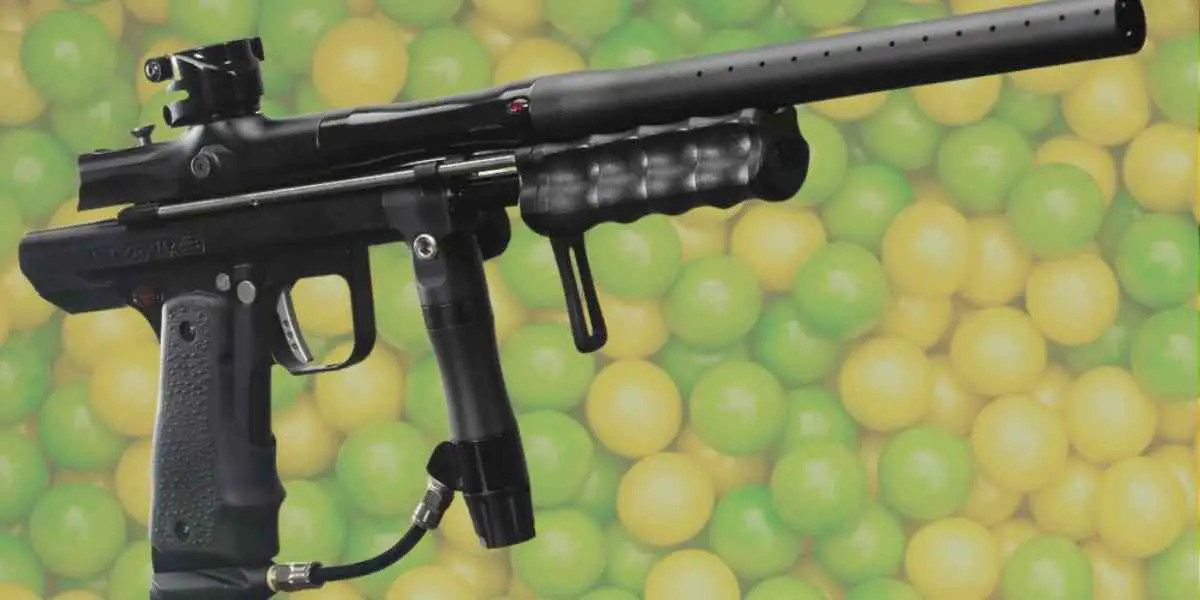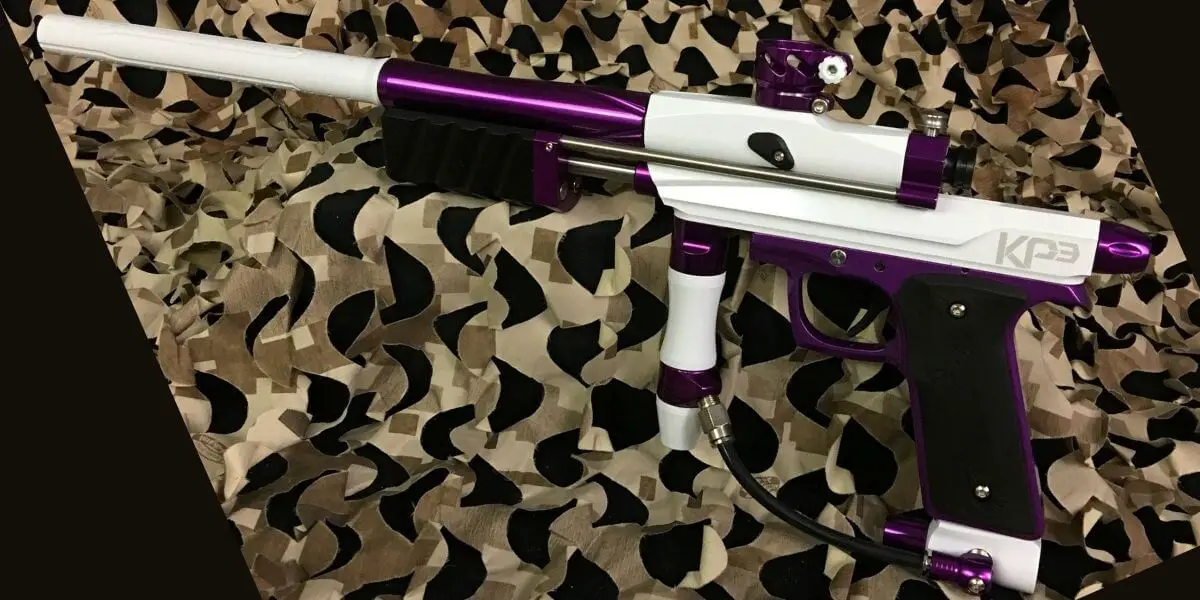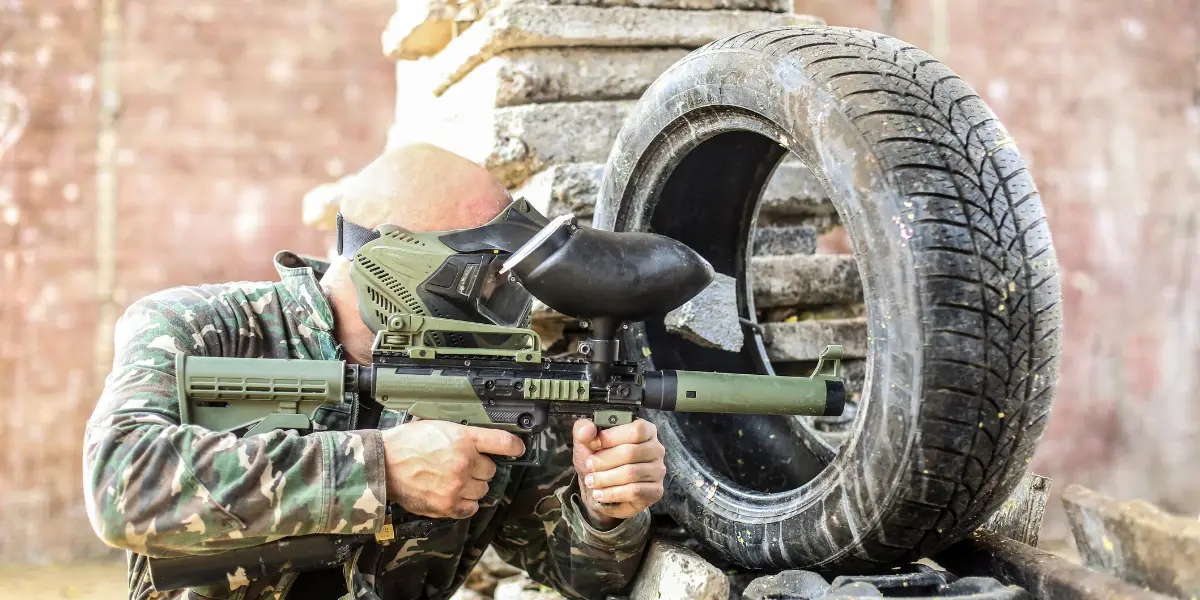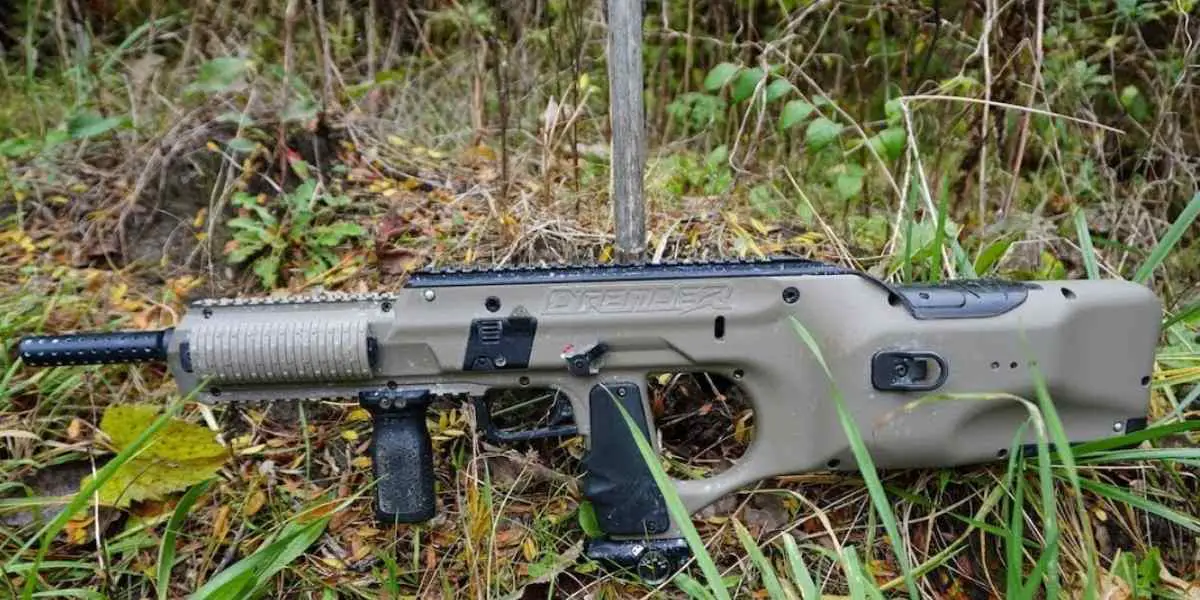
Today’s paintball markers are durable, rugged tools, but they won’t stay that way if they’re not properly maintained. While most paintball payers will be careful to keep their markers dry and free of debris, they’re not sure how to clean the weapon from the inside. In this guide, we’ll discuss how to clean a paintball marker inside out.
Before cleaning your marker, you should spend a few minutes reviewing the instructional manual. If the manual did not ship with the marker, try searching on the manufacturer’s website where you can review the manual online. Some markers have specific instructions that must be followed (for instance, specific details on how to degas the tanks safely). Look for anything that closely resembles your marker’s schematic as this will give you an idea about its parts. Here’s an example of what the drawings/schematics for a paintball marker.
The schematic will contain an overview of the various parts that make up the marker. Most markers have the same components and general outline, but it always helps to know the position, name, and function of your marker’s parts.
This is arguably the most important step because the tank can misfire and cause some serious injuries. No matter what the extent of your maintenance is, you should always disconnect the tank from the marker and degas it.
This prevents any chances of accidental firing while you’re working on the machine. Pressurized tanks are not toys and can cause serious injuries. Here are references to hand injuries and eye injuries related to pressurized tanks.
Some markers have ASA (air source adapters) levers attached at the bottom of the grip frame to aid in the removal of the gas canister. The ASA allows you to depressurize and safely remove the gas tank. Make sure to read the instructions carefully by consulting the instruction manual for your marker.
If your electronic marker uses batteries, make sure to remove it before working on any sort of maintenance on your marker and before storing it. This is true in the case of alkaline batteries since they leak easily. In the case of lithium batteries, you should check them every month or so. This keeps accidents during maintenance to a minimum.
For example, it is not unheard of for people to accidentally poke their batteries with something sharp such a screwdriver; this runs the risk of the batteries exploding and causing chemical injuries. Also, if the marker suddenly received power during maintenance, it could hurt you or break something.
It is easy to clean the barrel with the help of a pull-through squeegee. If your marker didn’t already ship with a small squeegee to use with the barrel, you can easily buy one from most paintball retailers. Here is a link to a squeegee that I like on Amazon, it's collapsible and you can take it on the filed in case you need to clean the barrel during a game.
Tip: Buy 2 squeegees. If a paintball breaks inside your barrel, then there's often too much paint for one squeegee to handle. Rinse them out at the end of the day to keep them good for the next battle.
Gently insert the squeegee into the barrel and gradually lift it. Repeat this motion until you are sure the barrel is clean. Make sure to wipe the squeegee between each pass.
The key is to remove all paint, and gunk. Do not skimp on cleaning the barrel, you want to make sure the bore of the barrel is squeaky clean before moving on to the next step.
Once you’re done with the squeegee, you can clear out the remainder of the residue with a moist cloth. It is very important to properly dry the barrel otherwise corrosion could set in, requiring you to completely replace the barrel.
Aside from ensuring that your marker functions safely and reliably, good barrel maintenance helps to maximize the marker’s life and preserve potential accuracy. How often you should clean the marker depends on many factors such as the paintball shooting environment, quality of paintball, and the number of times you fire the marker. Under normal conditions, you should be able to shoot the marker through an entire session without the need to clean.
Do keep in mind that certain paintball pellets foul a barrel faster than others, so cleaning the barrel periodically may be necessary. In the case of high humidity, freezing rain, blowing sand, and salt air, you will have to increase the frequency of cleaning. Whatever your current situation or conditions may be, you will need to adopt the proper barrel cleaning methodology.
All barrels foul to some degree after firing a few rounds of paintballs. Failure to remove the resulting debris results in the buildup of grime that compromises accuracy. The longer you wait to remove the gunk, the more difficult it gets to remove it.
In some paintball markers, you may need to use a squeegee to clean the marker’s interior. If you are not sure, make sure to consult the manufacturer’s instructions. The squeegee should help you reach all the nooks and crannies, and this means that it should be the right size. Too large, and it may not easily fit inside; in the off chance that a large squeegee does get inside, it will damage the interior.
You want to get all that paint and gunk off your marker. If you have any exposed areas on the marker, carefully observe it for any paint splatter. Make sure to clean the paint residue on the interior of the marker
If you don’t have a squeegee, you can use an old toothbrush or cotton swabs to clean the paintball marker. A small amount of warm water will help aid in the breakdown of hardened gunk. Make sure to air dry the marker’s body thoroughly to prevent corrosion after you’ve cleaned it.
This step depends entirely on the type of hopper your marker uses. This guide covers spring-loaded hoppers.
Start by disassembling the hopper. Most hoppers have standard flat-head screws securing it, and chances are you already have a spare flat-head screwdriver lying around. Remove all screws and store them in a tidy area around the table. Now gently split apart the magazine very carefully. You have to be careful because the hopper is spring-loaded and will pop out.
Before you start cleaning out the hopper, make sure the spring doesn’t get tangled up. Now take a look at the spooler to see if the string is properly winding down and isn’t worn or tangled. Clean the grooves on both sides of the hopper case with a microfiber cloth. Now make your way to the feeding neck of the paintball hopper to ensure all its bearings are intact.
Once the paintball hopper is clean, the next stage is going to be a little challenging: putting it back together. You have to carefully place the spring back into its original position, the easy way to do this is by ensuring that the ball end goes through the neck feed.
Once the spring and all its bearings are properly lined up, the hopper should snap back into place without applying excessive pressure. Now secure the hopper by installing the screws. Seal the screws with their screw covers (if you had them).
The next step is to remove the bolt and hammer to carefully clean them with a wet microfiber cloth. Make sure they are both thoroughly air-dried to prevent corrosion. Now inspect the O-rings on both the bolt and hammer. It is relatively easy to damage O-rings, but you can easily tell if they need replacement.
It is important to take your time with this because if you cut corners, especially when it comes to drying wet areas of the bolt and hammer, you run the risk of corroding the metal parts due to leftover moisture.
Over time, the O-rings in paintball markers crack and brittle, causing leaks that could make the marker unsuitable for use on the field. Watch this video on YouTube for a brief guide on how to replace the O-rings.
The grip frame of the paintball marker is the most important part that needs a thorough cleaning. It is easy for this component to get excess paintball splatter. You should be able to remove those by scrubbing the grip frame with a small toothbrush dipped in warm water. The grip frame is not sensitive to cleaning, but you have to be meticulous and thorough to ensure the marker is free of any debris that could cause malfunctions or clogs.
The grip frame houses the most important components that will make the paintball trigger work. It is not recommended to disassemble the grip frame since all the parts are so tiny and carefully engineered in place, you may not be able to put them back together. Not without expert guidance or special equipment.
Once you are sure all the parts are properly cleaned and sterilized, you can begin the process of lubrication. The first in the list are O-rings. Apply lube to them, but be careful not to overdo this because any leftover grease will make its way to other areas of the marker and contaminate them.
It is recommended to buy lubrication specifically designed for paintball markers. Other lubricants can cause serious damage to your marker and may even create safety issues. Most paintball markers come with a lubricant, which is made by the same manufacturer. This may seem like a clever marketing ploy, but it is designed to extend the lifespan of your marker. Using the wrong lubricant could end up voiding your marker’s warranty. For instance, if you use olive oil, hand moisturizer, or something else not intended for lubrication, the manufacturer will find out and won’t cover free repairs anymore.
Since you degassed your marker’s tank, you should now fill it with compressed air or CO2 liquid. Make sure to not overfill the tank because you run the risk of it blowing up on you and causing serious damage to both the equipment and you. Refilling the tank requires going back to the instruction manual to learn the recommended limits for the tank your marker is using.
Always look at the gauge on your marker’s tank to know how much air is inside the tank. As a general rule, if your tank is rated at 4500 psi, you should be okay with only 4000 psi of pressure.
Caution: If you are using CO2, make sure it does not enter the tank in liquid form. Only the vapors should enter the tank. It is easy to tell when the CO2 has liquefied: you will notice a thick, snowy cloud of air next to the barrel.
The right way to fill the tank is to keep the marker’s barrel pointed in an upward direction. Pointing down is only going to make things difficult for you because gravity will disrupt the flow of the gas. You must take your time filling the tank. Rushing the filling up process may result in injury. Alternatively, you can ask an expert to fill up the tank for you by visiting your local field fill station.
Once the marker is cleaned and lubricated, it is time to put Humpty Dumpty together again. If you have a schematic, make sure to consult it. Earlier in the guide, we recommended taking before, during and after pictures of the marker with a smartphone camera.
These pictures act just like a schematic and will help you keep track of the smaller parts if you’re unsure where to fit them. Being reckless with small parts can cause major issues later on. If you lost any of the small parts, you should not use the marker, for safety reasons.
It helps to have a video of someone demonstrating how to clean the paintball marker inside and out. There are many detailed tutorials on YouTube from experts who have been doing this for years. Click here to check a 3-minute video on cleaning paintball markers by eHowSports.
If you’re not too sure that you can clean the paintball marker, you can always pay someone else to do it for you. A professional would be more than happy to clean the paintball marker and they won’t charge you crazy amounts either. If you can, request them to let you watch the paintball marker cleaning process. This will give you a ‘hands-on’ view on how to clean the ins and outs of your paintball marker by an expert.
Paintball markers should be cleaned and a fresh coat of lubricant applied after use if they are going into storage and regularly if you play the game very often. In this case, the markers should be cleaned right after each session, stored in a clean area, carried in a clean environment, and regularly inspected for grime buildup and adequate lubrication. There’s no reason to sacrifice a marker’s reliability and accuracy when a few minutes of your time taking precautionary measures can prevent problems.
If you regularly bring your paintball marker on the field, then it is better to clean the marker after every two games (or two days – whichever comes first). In this way, you proactively clear out all the broken paintballs and dirt from your marker.
If you don’t regularly play paintball, such as once or twice a month, then it is better to clean it on the same day of use. Leaving the gunk and paintball splatter for one week or more will increase the chances of corroding your paintball marker.
There are a few tools and miscellaneous items you will need to clean your marker thoroughly. We recommend buying a paintball cleaning kit if you want all the necessary tools shipped to your doorstep in one order.
A plastic tray with multiple compartments doesn’t have to be very expensive. You can easily buy one from Amazon or eBay at an affordable price. A plastic tray will help you manage all the individual parts of the marker, such as screws, springs, and other internal components. It is relatively easy to lose track of small items while you’re taking your paintball marker apart and cleaning it.
A plastic tray isn’t the most essential tool in helping you clean your marker, but it can make your life much easier. You will thank yourself later when you have all tiny parts in to easy to manage tray.
You will need a few essential tools to take your marker apart properly. A multi tool kit or toolbox will contain essential items such as Phillips screwdrivers, a flat-head, a few wrenches, and even squeegees
There are many different types of paintball marker lubricants out there. Make sure to buy a manufacturer-recommended lubricant. Otherwise, you could compromise your paintball marker’s accuracy.
A squeegee is a tool that you can use to clean the nooks and crannies of your paintball marker’s interiors. My favorite, found at Amazon
Make sure the squeegee runs through the interior and back. Repeating this motion a few times will help you remove any buildup of gunk in your marker’s barrel. A squeegee is a great way to remove the gunk all at once, instead of amateurishly spreading it all around the marker.
Make sure to buy squeegees from paintball retailers, since they will have appropriate sizes for your marker’s barrel. Never use a squeegee that is bent out of shape. The bend will rub against the bore of the barrel and cause premature wear. Use straight, even strokes, taking care not to bend the squeegee while pulling and pushing it.
If you have a large paintball marker, such as rifles and shotguns, it helps to have some way of securing the marker firmly in place while you clean it. A good idea is to buy a marker vise (intended for normal markers).
It is a good idea to have a large workbench to keep all the marker’s parts in a nice and organized manner. To help you ventilated, you can buy a small and inexpensive fan to keep the environment more bearable.
A clean patch helps you clean the barrel, frame, and the marker’s magazine. They are inexpensive and easy to buy from most online retailers or find them at Amazon. These are sturdy and held in a plastic container to keep them good.
Sure you can use an old toothbrush that you haven’t been using to clean your teeth, but you can make the cleaning process much easier by buying a marker toothbrush. These specially designed tools can reach all the nooks and crannies. They will help you clean out the trigger parts and slide grooves. A marker toothbrush made of nylon should do the trick.
If you intend on storing the paintball marker for a long time, consider investing in a marker safe. Make sure to add a few drops of lubricant to the exterior, but be careful not to overdo this because the oil could get into areas of the marker where it is not supposed to.
Our recommendation is to buy an in-wall marker safe. These safes are designed to be extremely durable and will keep your marker completely safe from outside elements. Make sure it is locked to prevent children from gaining access to the safe.
If a marker safe is too expensive right now, you can make customized storage out of PVC or vinyl material. Here’s how:
It isn’t unheard of for paintballs to start leaking on the field. While it is easy to fix an air leak, you should not do this on the field. Move away from the action to perform repairs in a safe area. Inspect the marker to see where the air is leaking out from. If the leak is coming from a pressure release valve, the O-ring on the tank may be compromised. You will have to replace the O-ring with a new one (make sure it is properly lubricated).
If the leak is originating from where the tank enters the marker, the culprit could be the loose connection. This can be fixed by using an adjustable wrench to tighten the connection, make sure not to over-tighten it.
If air is leaking down the barrel of the paintball marker, it may require difficult repairs. You can temporarily fix this problem by adding a few drops of oil onto the ASA of the marker. Now check if the leak is fixed. If this temporary fix fails, then the problem is due to a worn cup seal. You can obtain a replacement cup seal for your specific marker from most paintball stores.
Once you’ve taken care of the leak, test the marker without loading any paintball pellets to see if it fired correctly. Spray some soapy water on potential areas where you suspect are leaking. The soapy water will bubble in the case of leaks.
To see if your paintball marker’s tank is working as planned, conduct a hydro test. This will expose any potential issues with the tank’s structural integrity. The test is easy to carry out. Simply submerge the paintball tank in water and increase the pressure to evaluate its mechanical strength and leaks.
A hydro test should be carried out every 5 years and helps you determine if the threading is preserved or not. Most paintball tanks will last at least 15 years, but you can never be sure if they stay complaint. You can check the date of the tank’s manufacture by inspecting the outside of the tank. If the information is not available, contact the manufacturer.
 Empire Paintball Sniper Pump Marker Review
Empire Paintball Sniper Pump Marker Review Azodin KP3.5 KAOS Review
Azodin KP3.5 KAOS Review Tippmann Cronus Review
Tippmann Cronus Review Empire BT DFender Review
Empire BT DFender Review